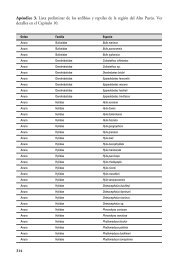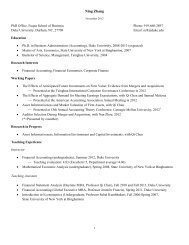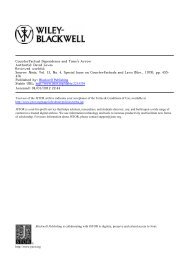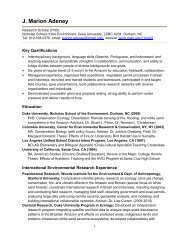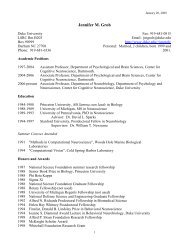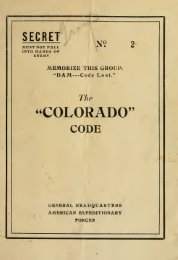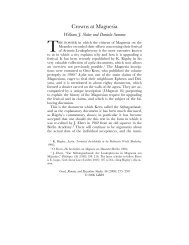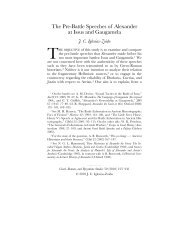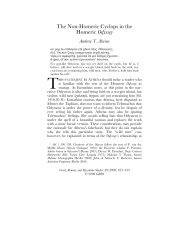Johann Wolfgang von Goethe (1749-1832) - Duke University
Johann Wolfgang von Goethe (1749-1832) - Duke University
Johann Wolfgang von Goethe (1749-1832) - Duke University
Create successful ePaper yourself
Turn your PDF publications into a flip-book with our unique Google optimized e-Paper software.
J. W. v. <strong>Goethe</strong> Page 12 4/4/2008<br />
<strong>Goethe</strong> worked steadily in the five years following<br />
Schiller's death to complete his vast Zur Farbenlehre<br />
(1810; translated as <strong>Goethe</strong>'s Theory of Colours, 1840),<br />
which he sometimes called his single most<br />
important work. It consists of three parts: an<br />
exposition of <strong>Goethe</strong>'s own theory of color, a<br />
polemic against the Newtonian theory that white<br />
light is a mixture of colors, and a collection of<br />
materials on the history of color theory from<br />
antiquity to <strong>Goethe</strong>'s own time. While <strong>Goethe</strong>'s<br />
theory has never been accepted by physicists, his<br />
insights on the perception of color have been<br />
influential, as has his recognition that scientific<br />
ideas are conditioned by their historical contexts.<br />
As in art, <strong>Goethe</strong>'s tastes in literature remained<br />
open to Romantic influence; to his continuing<br />
interest in Shakespeare and Calderón he added the<br />
medieval German epic the Nibelungenlied. He also<br />
followed the work of the new generation of poets,<br />
inside and outside of Germany, with great interest.<br />
In the theater he produced a series of plays by<br />
Calderón, stimulating thereby a lasting revival of<br />
his works; in addition, he produced plays by<br />
younger Romantic dramatists, such as Heinrich <strong>von</strong><br />
Kleist and Zacharias Werner. He continued writing<br />
court masques, but only one major dramatic work,<br />
the operatic fragment Pandora: Ein Taschenbuch für<br />
das Jahr 1810 (1810). He wrote poems steadily,<br />
experimenting with new forms in his first group of<br />
sonnets and trying out Persian attitudes and forms<br />
in the West-östlicher Divan (1819; translated as<br />
"West-Eastern Divan," 1874), a book of poems<br />
composed in response to the German translation of<br />
Hafiz. Like the "Römische Elegien," these poems,<br />
many of them masterpieces, are arranged into a<br />
sketchy plot that articulates the poet's encounter<br />
with Hafiz and the culture he represents. The<br />
collection embodies better than any of his work<br />
except Faust the aging poet's passionate concern for<br />
"Weltliteratur" (world literature), by which term<br />
<strong>Goethe</strong> summarized his belief in a literary tradition<br />
that transcended national boundaries. The Westöstlicher<br />
Divan also contains "Noten und<br />
Abhandlungen" (Notes and Treatises), brief essays<br />
on the history of Persian life and letters. As in his<br />
autobiographical and scientific writings,<br />
historical context had become indispensable to<br />
<strong>Goethe</strong>.<br />
Before Schiller's death <strong>Goethe</strong> had begun<br />
planning a sequel to Wilhelm Meisters Lehrjahre:<br />
Ein Roman that was, however, to be a cycle of<br />
novellas rather than a novel. Several of these<br />
novellas were written in the succeeding decade,<br />
but one of them so absorbed <strong>Goethe</strong>'s interest<br />
that it developed into a novel in its own right:<br />
Die Wahlverwandtschaften: Ein Roman (1809;<br />
translated as "Elective Affinities," 1854). The title<br />
refers metaphorically to the capacity of certain<br />
elements to displace others during chemical<br />
reactions. A young girl, Ottilie, and an unnamed<br />
captain arrive at the estate of Eduard and<br />
Charlotte, and a double displacement ensues:<br />
Eduard and Ottilie are attracted to each other, as<br />
are Charlotte and the captain. When Charlotte<br />
gives birth to her and Eduard's child, it bears,<br />
paradoxically, the features of Ottilie and the<br />
captain, with whom the spouses have<br />
committed adultery only in spirit. The situation<br />
is resolved only when Ottilie forbids Eduard to<br />
divorce Charlotte and then starves herself to<br />
death. The novel retraces the concerns of Die<br />
Leiden des jungen Werthers, but in a more abstract<br />
and symbolic fashion, as a third-person<br />
narrative with only inserted, impersonal diary<br />
passages and a full-scale inserted novella.<br />
Eduard is a middle-aged Werther who has<br />
survived the loss of his beloved Charlotte to<br />
marry her on the rebound from her first<br />
marriage. Confronting his selfishness and<br />
subjectivity is an inscrutable moral law<br />
embodied in a powerful natural environment<br />
and in the equally inscrutable Ottilie. The novel<br />
subtly leaves open to question the extent to<br />
which this law is not inherent in nature, but<br />
projected by the characters themselves. With its<br />
paradoxical double adultery, its frank treatment<br />
of divorce, its suicide, and its apparent<br />
apotheosis, the novel scandalized most of its<br />
readers; despite its undeniable and significant<br />
influence in the nineteenth century, especially in<br />
England and America, it only became a



